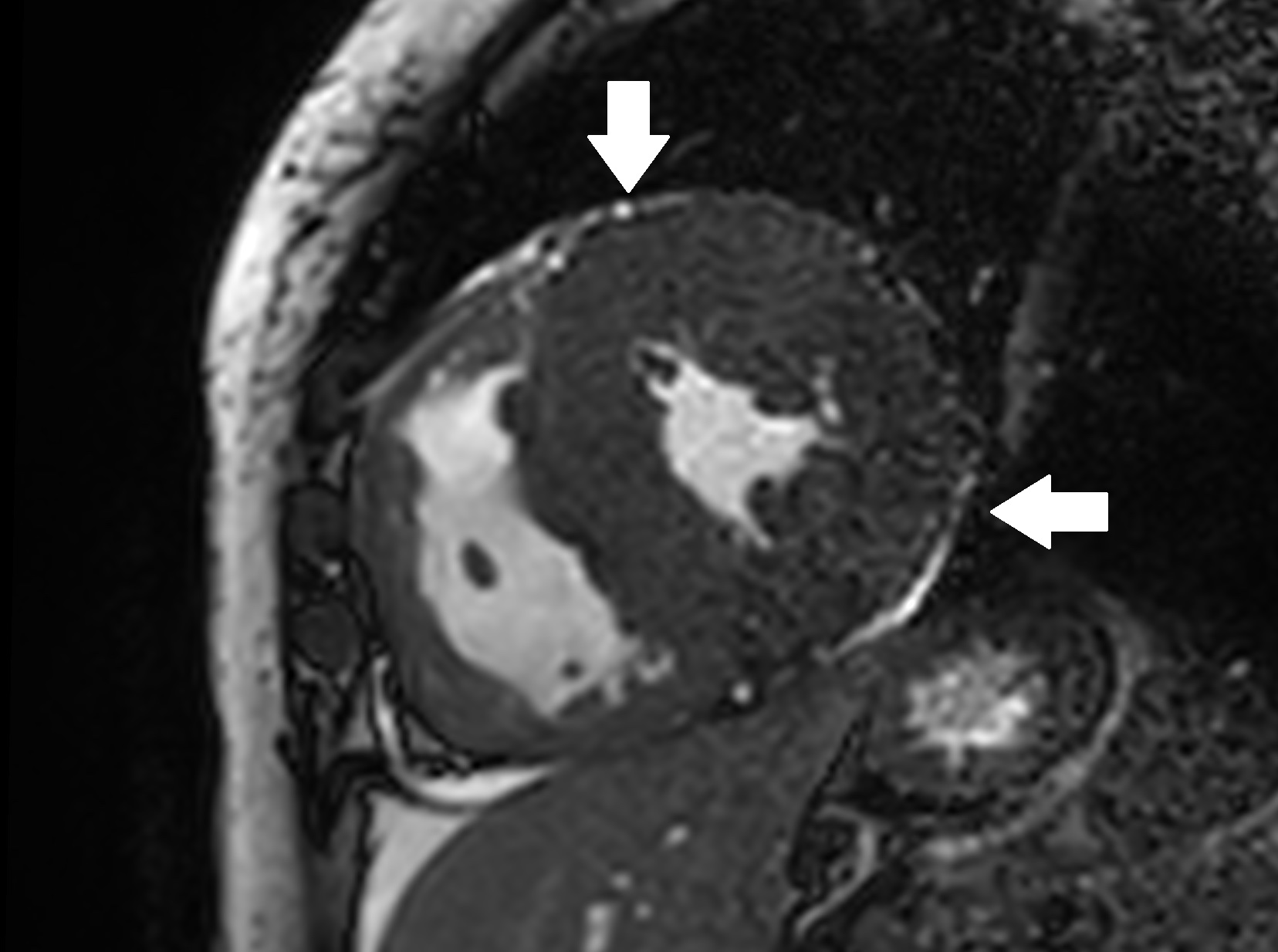|
|
| Line 7: |
Line 7: |
|
| |
|
| ==Cardiac MRI== | | ==Cardiac MRI== |
| CMR findings in cardiac amyloidosis include:<ref name="pmid20083070">{{cite journal |author=Austin BA, Tang WH, Rodriguez ER, ''et al.'' |title=Delayed hyper-enhancement magnetic resonance imaging provides incremental diagnostic and prognostic utility in suspected cardiac amyloidosis |journal=[[JACC. Cardiovascular Imaging]] |volume=2 |issue=12 |pages=1369–77 |year=2009 |month=December |pmid=20083070 |doi=10.1016/j.jcmg.2009.08.008 |url=}}</ref><ref name="pmid15630027">{{cite journal |author=Maceira AM, Joshi J, Prasad SK, ''et al.'' |title=Cardiovascular magnetic resonance in cardiac amyloidosis |journal=[[Circulation]] |volume=111 |issue=2 |pages=186–93 |year=2005 |month=January |pmid=15630027 |doi=10.1161/01.CIR.0000152819.97857.9D |url=}}</ref><ref name="pmid19195518">{{cite journal |author=Ruberg FL, Appelbaum E, Davidoff R, ''et al.'' |title=Diagnostic and prognostic utility of cardiovascular magnetic resonance imaging in light-chain cardiac amyloidosis |journal=[[The American Journal of Cardiology]] |volume=103 |issue=4 |pages=544–9 |year=2009 |month=February |pmid=19195518 |pmc=2680134 |doi=10.1016/j.amjcard.2008.09.105 |url=}}</ref><ref name="pmid19032744">{{cite journal |author=Maceira AM, Prasad SK, Hawkins PN, Roughton M, Pennell DJ |title=Cardiovascular magnetic resonance and prognosis in cardiac amyloidosis |journal=[[Journal of Cardiovascular Magnetic Resonance : Official Journal of the Society for Cardiovascular Magnetic Resonance]] |volume=10 |issue= |pages=54 |year=2008 |pmid=19032744 |pmc=2605441 |doi=10.1186/1532-429X-10-54 |url=}}</ref><ref name="pmid17700279">{{cite journal |author=Hosch W, Bock M, Libicher M, ''et al.'' |title=MR-relaxometry of myocardial tissue: significant elevation of T1 and T2 relaxation times in cardiac amyloidosis |journal=[[Investigative Radiology]] |volume=42 |issue=9 |pages=636–42 |year=2007 |month=September |pmid=17700279 |doi=10.1097/RLI.0b013e318059e021 |url=}}</ref><ref name="pmid19780184">{{cite journal |author=Sparrow P, Amirabadi A, Sussman MS, Paul N, Merchant N |title=Quantitative assessment of myocardial T2 relaxation times in cardiac amyloidosis |journal=[[Journal of Magnetic Resonance Imaging : JMRI]] |volume=30 |issue=5 |pages=942–6 |year=2009 |month=November |pmid=19780184 |doi=10.1002/jmri.21918 |url=}}</ref>
| |
| * Global subendocardial signal enhancement in the late washout phase (late gadolinium enhancement [LGE]) during delayed enhanced imaging. This finding is strongly suggestive of cardiac amyloid as it is rarely seen in other [[cardiomyopathy|cardiomyopathies]].<ref name="pmid18325442">{{cite journal |author=Vogelsberg H, Mahrholdt H, Deluigi CC, ''et al.'' |title=Cardiovascular magnetic resonance in clinically suspected cardiac amyloidosis: noninvasive imaging compared to endomyocardial biopsy |journal=[[Journal of the American College of Cardiology]] |volume=51 |issue=10 |pages=1022–30 |year=2008 |month=March |pmid=18325442 |doi=10.1016/j.jacc.2007.10.049 |url=}}</ref><ref name="pmid20159642">{{cite journal |author=Syed IS, Glockner JF, Feng D, ''et al.'' |title=Role of cardiac magnetic resonance imaging in the detection of cardiac amyloidosis |journal=[[JACC. Cardiovascular Imaging]] |volume=3 |issue=2 |pages=155–64 |year=2010 |month=February |pmid=20159642 |doi=10.1016/j.jcmg.2009.09.023 |url=}}</ref>
| |
| * Increased gadolinium wash-out time
| |
| * Abnormal myocardial and blood-pool gadolinium kinetics
| |
| * Brighter appearance of the myocardium compared to normal [[myocardium]]
| |
|
| |
| CMR has a sensitivity of 88% and a specificity of 95% in the diagnosis and is considered the most accurate predictor of [[biopsy]] positive cardiac amyloidosis.
| |
|
| |
| ===Advantages===
| |
| * More sensitive than echo as LGE can be present in patients with amyloidosis with normal ventricular wall thickness also.
| |
|
| |
| ===Dis-advantages===
| |
| * Caution should be maintained in patients with [[renal failure]].
| |
|
| |
| ===ACC/AHA Guidelines- ACCF/ACR/AHA/NASCI/SCMR 2010 Expert Consensus Document on Cardiovascular Magnetic Resonance<ref name="pmid20479157">{{cite journal| author=American College of Cardiology Foundation Task Force on Expert Consensus Documents. Hundley WG, Bluemke DA, Finn JP, Flamm SD, Fogel MA et al.| title=ACCF/ACR/AHA/NASCI/SCMR 2010 expert consensus document on cardiovascular magnetic resonance: a report of the American College of Cardiology Foundation Task Force on Expert Consensus Documents. | journal=Circulation | year= 2010 | volume= 121 | issue= 22 | pages= 2462-508 | pmid=20479157 | doi=10.1161/CIR.0b013e3181d44a8f | pmc=PMC3034132 | url=http://www.ncbi.nlm.nih.gov/entrez/eutils/elink.fcgi?dbfrom=pubmed&tool=sumsearch.org/cite&retmode=ref&cmd=prlinks&id=20479157 }} </ref> (DO NOT EDIT)===
| |
| {{cquote|
| |
| CMR may be used for assessment of patients with LV dysfunction or hypertrophy or suspected forms of cardiac injury not related to ischemic heart disease. When the diagnosis is unclear, CMR may be considered to identify the etiology of cardiac dysfunction in patients presenting with heart failure, including
| |
| *Evaluation of [[dilated cardiomyopathy]] in the setting of normal coronary arteries
| |
| *Patients with positive cardiac enzymes without obstructive [[atherosclerosis]] on [[angiography]]
| |
| *Patients suspected of [[amyloidosis]] or other infiltrative diseases
| |
| *[[Hypertrophic cardiomyopathy]]
| |
| *[[Arrhythmogenic right ventricular dysplasia]]
| |
| *[[Syncope]] or [[ventricular arrhythmia]]
| |
| }}
| |
|
| |
|
| ==Images== | | ==Images== |

